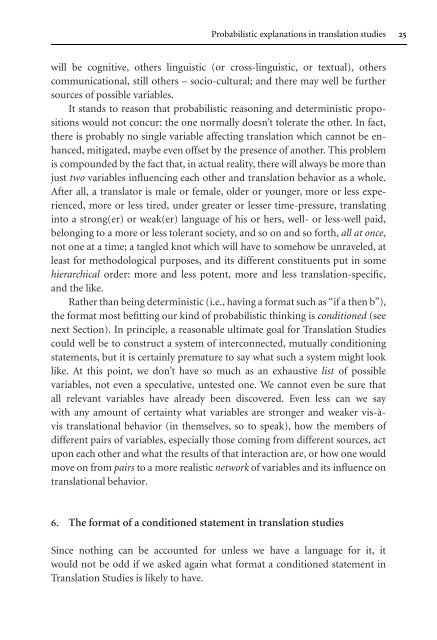Translation Universals.pdf - ymerleksi - home
Translation Universals.pdf - ymerleksi - home
Translation Universals.pdf - ymerleksi - home
You also want an ePaper? Increase the reach of your titles
YUMPU automatically turns print PDFs into web optimized ePapers that Google loves.
Probabilistic explanations in translation studies 25<br />
will be cognitive, others linguistic (or cross-linguistic, or textual), others<br />
communicational, still others – socio-cultural; and there may well be further<br />
sources of possible variables.<br />
It stands to reason that probabilistic reasoning and deterministic propositions<br />
would not concur: the one normally doesn’t tolerate the other. In fact,<br />
there is probably no single variable affecting translation which cannot be enhanced,<br />
mitigated, maybe even offset by the presence of another. This problem<br />
is compounded by the fact that, in actual reality, there will always be more than<br />
just two variables influencing each other and translation behavior as a whole.<br />
After all, a translator is male or female, older or younger, more or less experienced,<br />
more or less tired, under greater or lesser time-pressure, translating<br />
into a strong(er) or weak(er) language of his or hers, well- or less-well paid,<br />
belonging to a more or less tolerant society, and so on and so forth, all at once,<br />
not one at a time; a tangled knot which will have to somehow be unraveled, at<br />
least for methodological purposes, and its different constituents put in some<br />
hierarchical order: more and less potent, more and less translation-specific,<br />
and the like.<br />
Rather than being deterministic (i.e., having a format such as “if a then b”),<br />
the format most befitting our kind of probabilistic thinking is conditioned (see<br />
next Section). In principle, a reasonable ultimate goal for <strong>Translation</strong> Studies<br />
could well be to construct a system of interconnected, mutually conditioning<br />
statements, but it is certainly premature to say what such a system might look<br />
like. At this point, we don’t have so much as an exhaustive list of possible<br />
variables, not even a speculative, untested one. We cannot even be sure that<br />
all relevant variables have already been discovered. Even less can we say<br />
with any amount of certainty what variables are stronger and weaker vis-àvis<br />
translational behavior (in themselves, so to speak), how the members of<br />
different pairs of variables, especially those coming from different sources, act<br />
upon each other and what the results of that interaction are, or how one would<br />
move on from pairs to a more realistic network of variables and its influence on<br />
translational behavior.<br />
6. The format of a conditioned statement in translation studies<br />
Since nothing can be accounted for unless we have a language for it, it<br />
would not be odd if we asked again what format a conditioned statement in<br />
<strong>Translation</strong> Studies is likely to have.
















